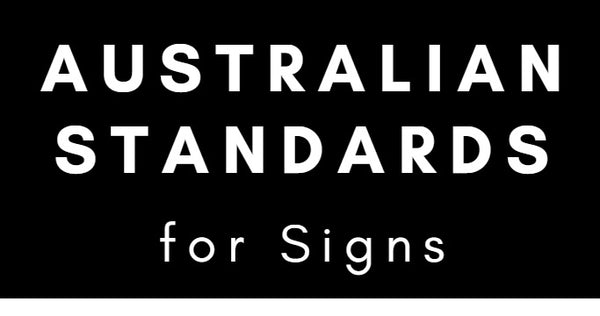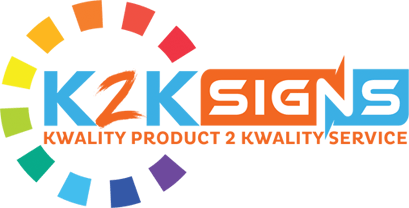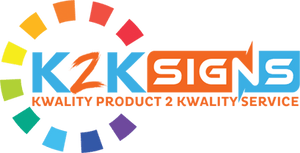Australian Standard Safety Signs
In this article, we will be looking and six types of safety signs that are used as per Australian Standards.

What are Australian Standards and Guidelines for Signs?
The Australian Guidelines for signs are developed by Standard Australia. These guidelines define the necessary information and symbols to be used on advertising signage in Australia.
These guidelines are an Australian standard for signage design, which in their turn has been developed by industry consensus.
The Australian Guidelines for signs were first released in 1980 and were revised in 2005. The guidelines adopted the use of international standardized sign symbols to facilitate global trade and communication.
The internationally recognized set of visual symbols consists of ten basic shapes: circles , squares, triangles, rectangles, stars, letters of the alphabet (both upper- and lower-case), numbers, chevrons and arrows.
Safety Signs
Safety signs are a necessity in any workplace. They warn people of hazards and keep them safe.
and keep them safe. Safety signs are not just used in Australia, they are also used in many other countries around the world. The safety signs that are used in Australia have been standardized as per Australian Standards AS1319:2004.
This standard defines the different types of safety signs that can be used according to the type of hazard or danger present at the workplace.
It also provides information about what each type of sign means and how it should be displayed for maximum efficacy.
As per AS1319:2004, there is a classification system for all types of safety sign
The Australian Standards for safety signs are divided into six categories:
- Prohibition Signs
- Mandatory Signs
- Danger Signs
- Warning Signs
- Emergency Signs
- Fire Signs
The Australian Standards for safety signs cover a wide range of topics and there are different types of safety signs for each topic.
Prohibition Signs
The prohibition signs are used to indicate a precautionary restriction in a workplace. These signs may be seen as necessary and important for ensuring that the workplace remains safe.
a workplace. These signs may be seen as necessary and important for ensuring that the workplace remains safe.The general principle behind these types of safety sign is to prevent or stop something from happening in the workplace, such as fire or injury.
Prohibition Signs should have a white background with red annulus and a slash symbol.
The following are some examples of prohibition signs:
- Don't enter
- No smoking in the building
- Keep off the pipes/equipment
Mandatory Signs
The mandatory signs are used to indicate a duty or obligation that is legally required. These safety signs can be seen as important for ensuring workplace safety and complying with regulations.
legally required. These safety signs can be seen as important for ensuring workplace safety and complying with regulations. Mandatory Signs should have a white symbol with a blue disc background. These signs should always have the word ‘must’ in them.
Some examples of mandatory signs are:
- You Must Sanitise Your Hands
- Foot Protection Must be Worn
- Hands Must be Washed Before Returning to Work
- All Visitors Must Register at Office
- Gloves Must be Worn in This Area
Danger Signs
The danger sign type is used to warn people of something that could be potentially life-threatening if it does not change in some way. For non life-threatening conditions, warning signs should be used.
potentially life-threatening if it does not change in some way. For non life-threatening conditions, warning signs should be used.Danger may also refer to the potential of the situation in question to cause pain or death. Danger signs are most often used to warn people of something they might not know about beforehand.
A Danger Sign should have a red oval shape over a black background with the word ‘Danger’ written in white.
Some examples of Danger Signs are:
- Danger - Flammable
- Danger - No Smoking
- Danger - Asbestos
- Danger - Flammable Gas
- Danger - Hazardous Materials
Warning Signs
Warning Signages are used to warn people about potential danger. They are also used to inform people about the presence of hazards in the environment.
also used to inform people about the presence of hazards in the environment.Warning signages may be found on roads, near dangerous equipment and in many other places where hazardous conditions exist.
They are an important part of safety and need to be clearly visible so that they can be read easily and quickly by the person who is approaching or is at risk of entering a potentially hazardous area.
Warning Signs should have a yellow background with a black triangle and an exclamation mark.
Below are some examples of Warning Signs:
- Warning - Infectious Waste
- Warning - Reduce Speed
- Warning - Video Surveillance in Use
- Warning - Nailing Tool in Use
- Warning - Dogs on Premises
Emergency Signs
Emergency signages are signs that are usually found in public places and they provide information on how to deal with emergencies. They are usually found in places where people gather such as schools, shopping malls, offices, factories and airports.
provide information on how to deal with emergencies. They are usually found in places where people gather such as schools, shopping malls, offices, factories and airports.The emergency signages have different colours and shapes which can indicate what kind of emergency is happening. For example, if the emergency is a fire then the sign will be red with a triangle-shaped arrow on it. If the emergency is an earthquake then the sign will be blue with a shaking symbol on it.
Emergency signs should be green in colour. The text on symbol on Emergency Signs should be white in colour.
Examples of Emergency Signages:
- Emergency Oxygen Equipment
- Emergency Exit Only
- Emergency Assembly Point
- Emergency Mains Gas Cut off
- Emergency vehicles Only
Fire Signs
Fire Signs are signs used to advise the location of fire alarms and fire fighting facilities.
facilities. These signs should be rectangular in shape and red in colour. The symbols or words on Fire Signs should be white in colour.
Examples of Fire Signs:
- Fire Hydrant Sign
- Fire Blanket Sign
- Fire Extinguisher Sign
- Fire Water Sign

